Reviews
Pierre Huyghe’s Mindblowing Installation and 4 Other Highlights From Skulptur Projekte Münster
An incredible breathing puzzle of Huyghe's making, and other remarkable highlights from the Münster decennial.
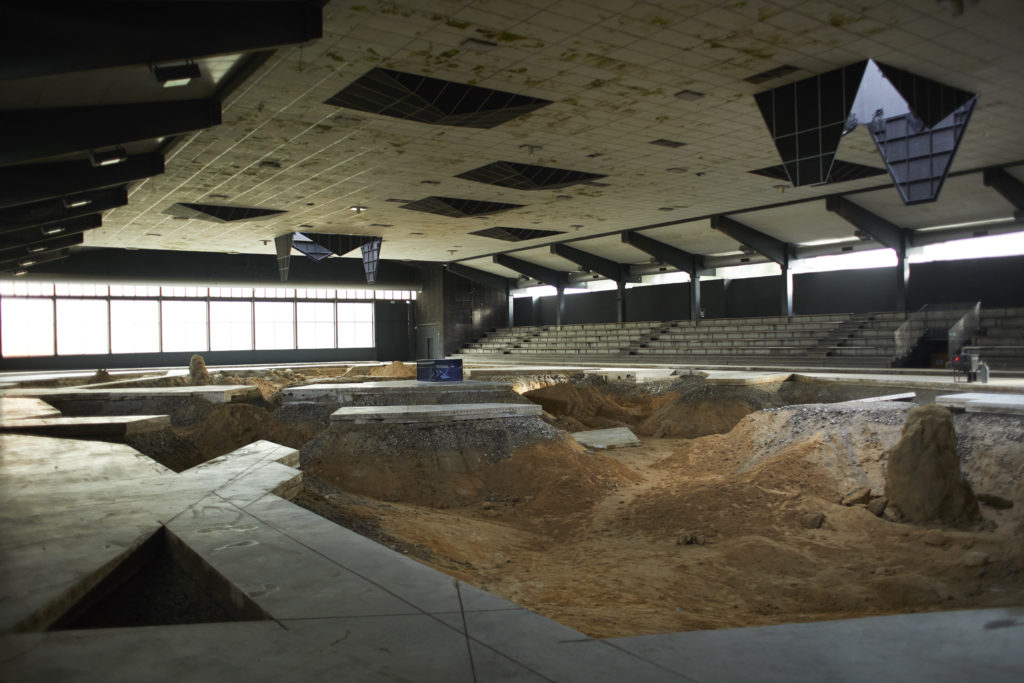
An incredible breathing puzzle of Huyghe's making, and other remarkable highlights from the Münster decennial.

Hili Perlson

The fifth edition of Skulptur Projekte Münster, the decennial exhibition dedicated to the medium of sculpture as public art, opened this past weekend in the quaint German city and—for the first time in its history—in the neighboring city, Marl.
In addition to spilling over to another municipality, this edition was marked by a string of departures from the ordinary: First, the very definition of sculpture in public space was extended to include both video and performance art. Second, the exhibition’s artistic director, the renowned German curator Kasper König, was sitting with a bandaged leg in a wheelchair whenever he appeared at a formal function. When spotted visiting the show off the clock, however, he was upright and sprightly as ever.
This year’s edition of the decennial had a number of outstanding pieces that are worth the trip (or a bike ride) to the far-flung corners of the city, although some works are admittedly not so easy to find. While it was easy to be seduced by the works’ accessible appeal (especially for those visitors who came directly from Kassel, where documenta 14 held one of its most aesthetically depressing editions to date), it by no means meant that SPM 2017 was lacking politically relevant content. Take Oscar Tuazon’s concrete sculpture by the port, Burn the Formwork, which doubles as an oven (for heat or cooking for those without shelter). Or Ayse Erkmen’s submerged bridge, On Water, which connects two banks in the industrial port area via a platform placed just underneath the water level, allowing people to cross (and dip their feet in), but blocking this part of the canal for vessels of any size, thus claiming a part of the city hitherto inaccessible to pedestrians.
But perhaps the most political statement of the show is that rather than “exploring,” “tackling,” or “thematizing” the European refugee crisis with well-meaning artworks, SPM 2017 hosts guided tours in a variety of languages, including Arabic, Turkish, Dari/Farsi, and basic German for learners of the language, thus reflecting the diverse social fabric of Germany today.
But if this edition will be remembered for one thing, it will certainly be Pierre Huyghe’s mind-blowing living, breathing installation, After ALife Ahead.
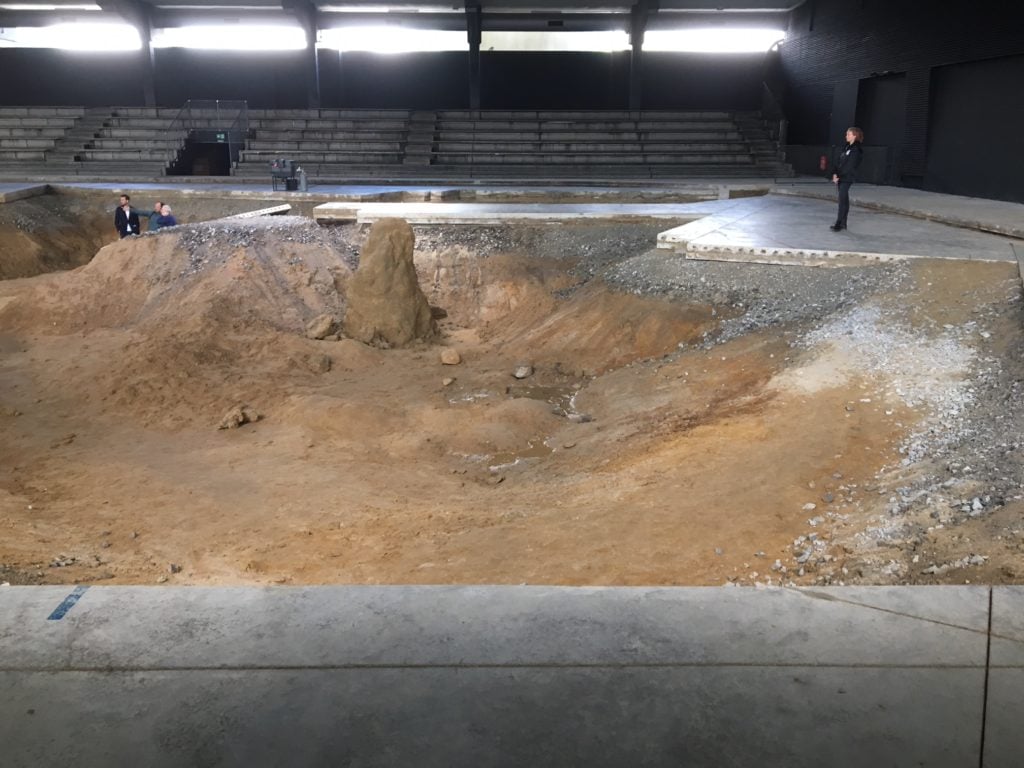
Pierre Huyghe, After ALife Ahead (2017). Installation at Skulptur Projekte2017. Photo Hili Perlson
Pierre Huyghe, After ALife Ahead
Exactly five years after his unforgettable landscape for documenta 13, pink-legged dog and all, Huyghe created another expansive installation that is a complex living organism, this time not in the open, like he did in Kassel’s Karlsaue Park in 2012, but in a disused ice rink that already shows signs of decay on its interior and moldy ceiling.
Huyghe cut up the concrete floor creating a muddy landscape that follows the design of a 3D puzzle used in IQ tests. Everything about the space is alive: A pillar of dirt is actually a bee hive; drawn to the light, two stunning chimeric peacocks cling to the glass windows at opposite ends of the rink.
An aquarium made of black switchable glass turns translucent when catching light coming from a contraption in the ceiling that opens and closes according to the space’s temperature and humidity levels. In fact, everything about this hall is controlled to create specific climate conditions reflecting the rate at which human cancer cells—the historically but also medically problematic HeLa cells—placed inside an incubator divide and multiply. To this critic, the work felt darkly gripping, with nature’s mutations and anomalies at the steering wheel.
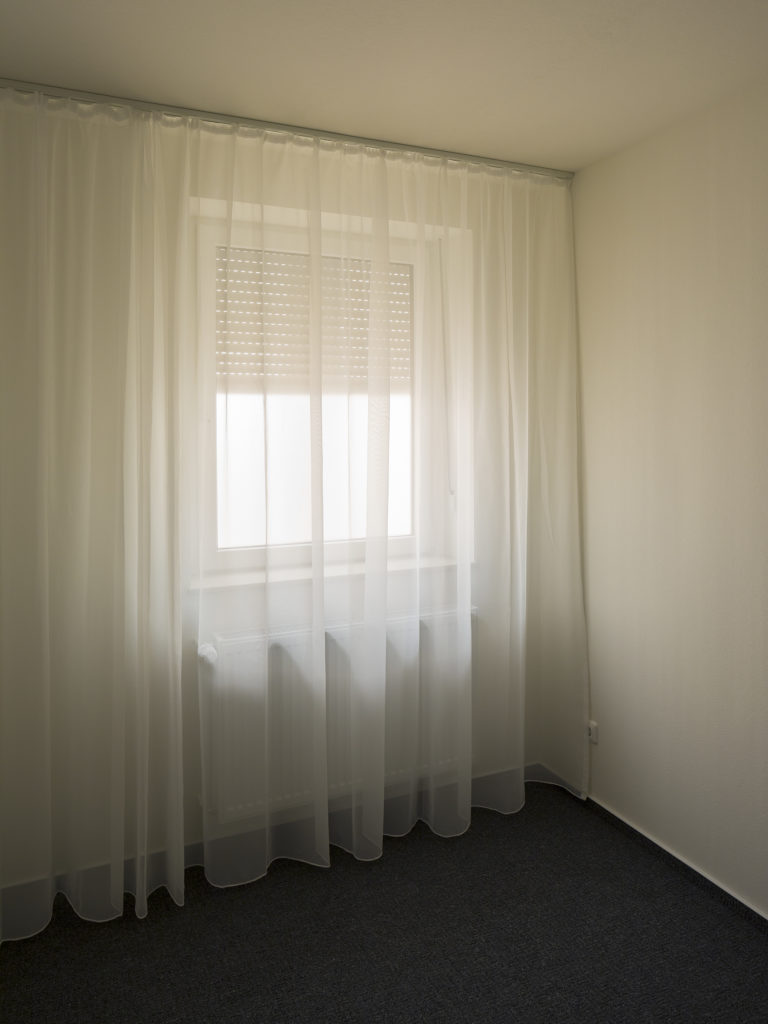
Gregor Schneider, N. Schmidt, Pferdegasse 19, 48143 Münster, Deutschland, ©Skulptur Projekte 2017. Photo: Henning Rogge
Gregor Schneider, N. Schmidt, Pferdegasse 19, 48143 Münster, Deutschland
After his major show at the Bundeskunsthalle, the Art and Exhibition Hall of the Federal Republic of Germany in Bonn earlier this year, we’ve already wondered whether 2017 will mark a turning point in German artist Gregor Schneider’s career, which was abruptly interrupted in the early aughts, allegedly due to his temperament.
To see his work for SPM, visitors had to queue for at least 90 minutes during opening weekend, but for those familiar with his chilling Merzbau-like work, which goes into the heart of German domestic Spießigkeit—an epithet used to describe a morally flawed mainstream German middle class—it was worth the wait.
On the top floor of the LWL museum, Schneider constructed an apartment belonging to one N. Schmidt, according to the name on the buzzer. Access to the disorienting work is only allowed individually, and one is immediately confronted with the scent of air fresheners in what is set up to look like a hallway. Entering the “apartment,” each empty room is lit differently, with one distinctive detail hinting at its function. Each room also has a very discrete smell.
One door opens to the bathroom, which reeks of toxic-smelling cleaning products. But something has gone wrong—water is running from the faucet, the shower head is leaking, and it seems like someone forgot to flush the toilet. What to do?

Cosima von Bonin & Tom Burr, Benz Bonin Burr, ©Skulptur Projekte 2017. Photo: Henning Rogge
Cosima von Bonin & Tom Burr, Benz Bonin Burr
There’s also lighter fare on view, and plenty of moments of comic relief, and one piece in particular also cheekily nods to the origins of SPM.
Outside the museum, in front of the entrance to the local Kunstverein, where a show of Tom Burr is currently on view, the American artist collaborated with his longtime friend, German sculptor Cosima von Bonin, on a work for SPM. They placed a huge Mercedes Benz loader on the sidewalk, in the court leading to both the LWL Museum and the Kunstverein. The truck obstructs the view of the Henry Moore bronze prominently placed there; it also carries a large wooden container that seems to be designed to house the massive sculpture. Is it being craned and shipped away?
According to locals, this collaborative piece is a tongue-in-cheek reminder of the harsh reactions to the first edition of SPM, back in 1977, when the citizens of Münster thought they were getting a show full of inoffensive, elegant Moores, and were suddenly confronted with conceptual, minimal works instead.
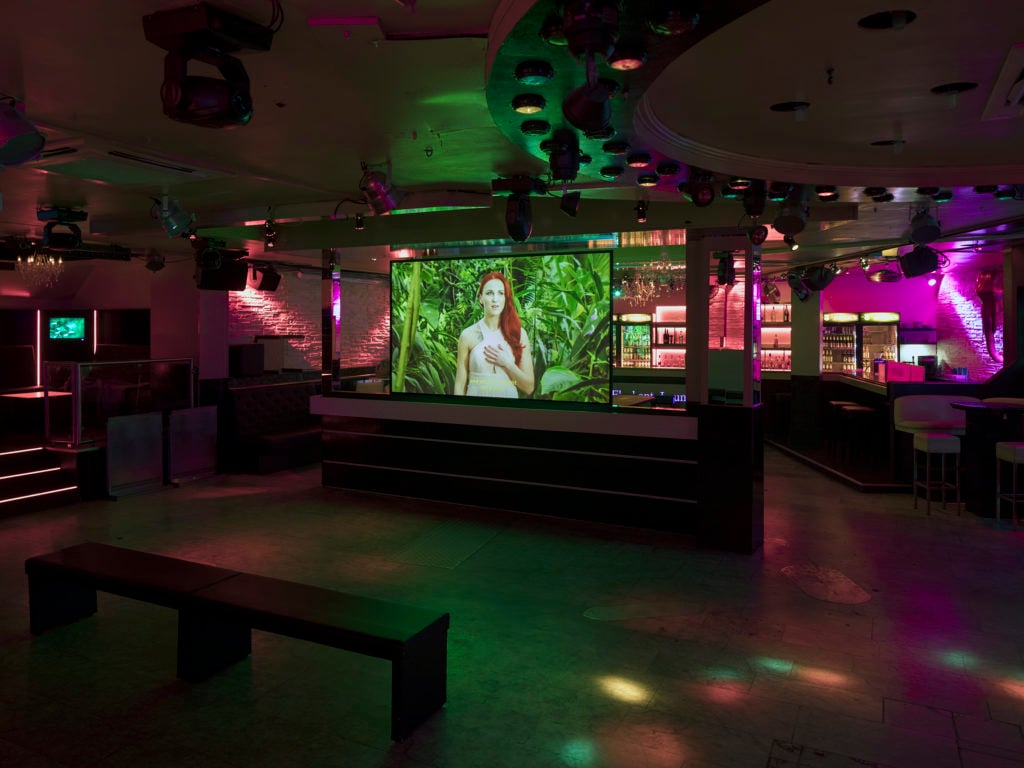
Bárbara Wagner und Benjamin de Burca, Bye Bye Deutschland! Eine Lebensmelodie, ©Skulptur Projekte 2017. Photo: Henning Rogge
Bárbara Wagner und Benjamin de Burca, Bye Bye Deutschland! Eine Lebensmelodie
Installed inside a ’70s-era discotheque called “The Elephant Lounge,” the video work by the artist duo Wagner/de Burca explores the musical style of prototypical popular German softcore pop known as Schlager. The artists, who are based in Brazil, filmed video clips for the popular hits in the city of Münster, drawing on its geography, which is dotted by sculptures that remained in public space from previous iterations of the decennial exhibition.
The narrative strings together the low-brow pop songs, performed by a local couple—professional singers who cover the Schlager hits of two German superstars. The work successfully stretches the definition of public sculpture, where everything, including the passageway leading to the tacky club and the badly translated signs (what should have been “no self-service” reads “no self-consumption” in English) constitute the sculptural elements of the space.
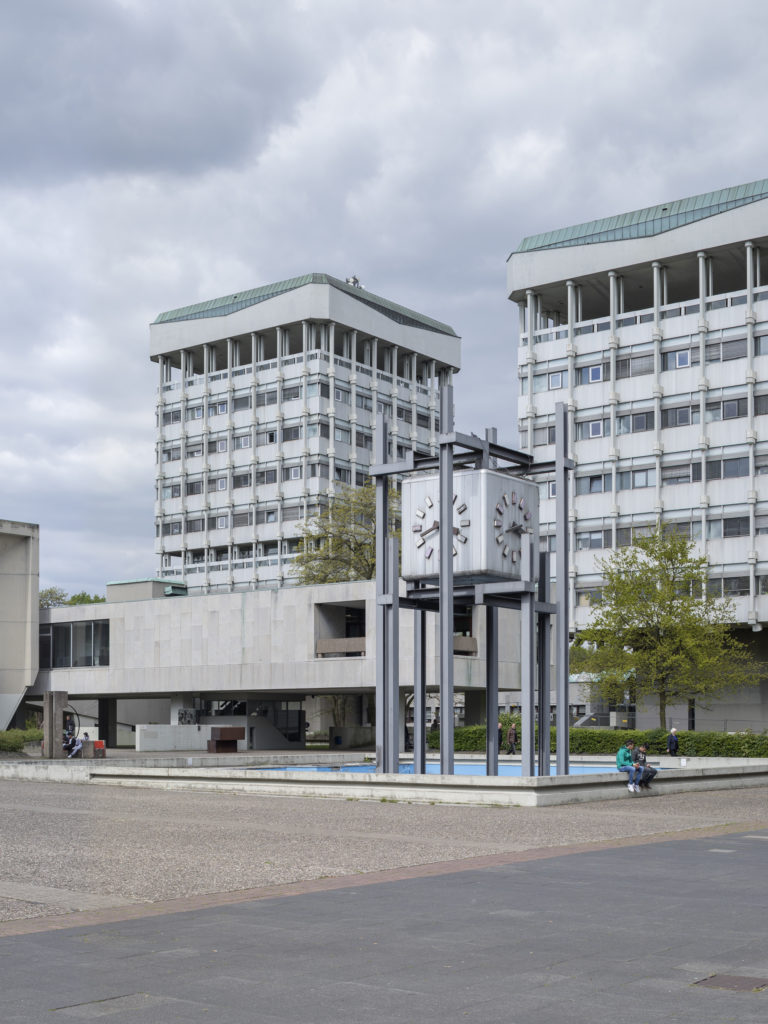
Town Hall Marl, ©Skulptur Projekte 2017. Photo: Henning Rogge
“The Hot Wire,” Marl
There’s a lot to see in Münster, and most visitors will want to find older works around the city in addition to the 35 new site-specific productions scattered around town. Going to another city on top of that may sound like a bit of an effort, but do not miss the chance to join one of the guided tours to “The Hot Wire,” the part of SPM 2017 that extends to Marl.
The locality couldn’t be more different than Münster: heavily bombed in WWII, it was largely rebuilt in the Modernist, post-war-era style of Internationalism. The city itself feels like a Brutalist monument. Once a booming economy from the coal industry, Marl today suffers from population decline, and many of its buildings, designed by famous 20th-century architects, stand empty and abandoned.
For the exhibition, some sculptures from previous editions of SPM were relocated here, including Richard Artschwager’s Bicycle Stand (1987). Thomas Schütte, whose iconic cherry pillar from the 1987 edition became a symbol of the show, didn’t want the sculpture moved for structural concerns, so he built a new one for Marl, slightly bigger, and this time with three slices of watermelon.
Inside the Glaskasten Museum, the main venue for “The Hot Wire,” which otherwise stretches across the adjacent park to the vacant school on its other end, true treasures await. The museum is showing Dominique Gonzalez-Foerster’s Roman de Münster, a piece created for the 2007 edition that shows small-scale replicas of selected sculptures from past Skulptur Projekte exhibitions. In the museum’s basement, visitors will discover the amazing collection of models of realized and unrealized proposals for previous editions.
Skulptur Projekte Münster runs from June 10 – October 1, 2017